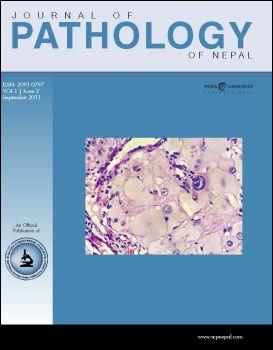Role of immunohistochemistry in the diagnosis of malignant small round cell tumors
DOI:
https://doi.org/10.3126/jpn.v1i2.5398Keywords:
Immunohistochemistry, Malignant Small Round Cell Tumor, Non Hodgkin’s Lymphoma, Ewing’s Sarcoma, RhabdomyosarcomaAbstract
Background: Immunohistochemistry is a key tool for the analysis of localization of target molecules within tissues. It has a significant role in the identification of tumors lacking evidence of lineage differentiation on the basis of routine light microscopic morphology alone. Approximately 90% of tumors posing diagnostic difficulties by morphology could be accurately classified by exploiting immunohistochemistry. The aim of this study is to identify the true identity of malignant small round cell tumors by immunohistochemical analysis.
Materials and Methods:This was a retrospective study done in Department of Histopathology of B.P.Koirala Memorial Cancer Hospital from January 2010 to April 2011.A total of 40 cases small round cell tumors were selected for immunostaining. The immunohistochemistry technique used is the Polymer detection-EnvisionTM System, a two step staining technique based on Horse Radish Peroxidase labeled dextran polymer technology (DAKO Company).
Results: Out of 40 cases of malignant small round cell tumors, there were 21 cases (52.5%) of Non- Hodgkin Lymphoma , 11 cases (27.5%) of Ewing’s Sarcoma/Primitive Neuroectodermal Tumor, 1 case (2.5%) of Lymphoblastic Lymphoma , 1 case (2.5%) of Rhabdomyosarcoma, 2 cases (5%) of Low grade neuroendocrine tumor, 1 case (2.5%) of Neuroblastoma, 2 cases (5%) of Poorly differentiated Synovial Sarcoma (small cell variant), 1case (2.5%) of Malignant Melanoma (small cell variant).
Conclusion: Immunohistochemistry is a valuable adjunct to routine hematoxylin and eosin staining for adequate and accurate categorization of malignant small round cell tumors.
Keywords: Immunohistochemistry; Malignant Small Round Cell Tumor; Non Hodgkin’s Lymphoma; Ewing’s Sarcoma; Rhabdomyosarcoma
DOI: http://dx.doi.org/10.3126/jpn.v1i2.5398
JPN 2011; 1(2): 87-91
Downloads
Downloads
How to Cite
Issue
Section
License
This license enables reusers to distribute, remix, adapt, and build upon the material in any medium or format, so long as attribution is given to the creator. The license allows for commercial use.




